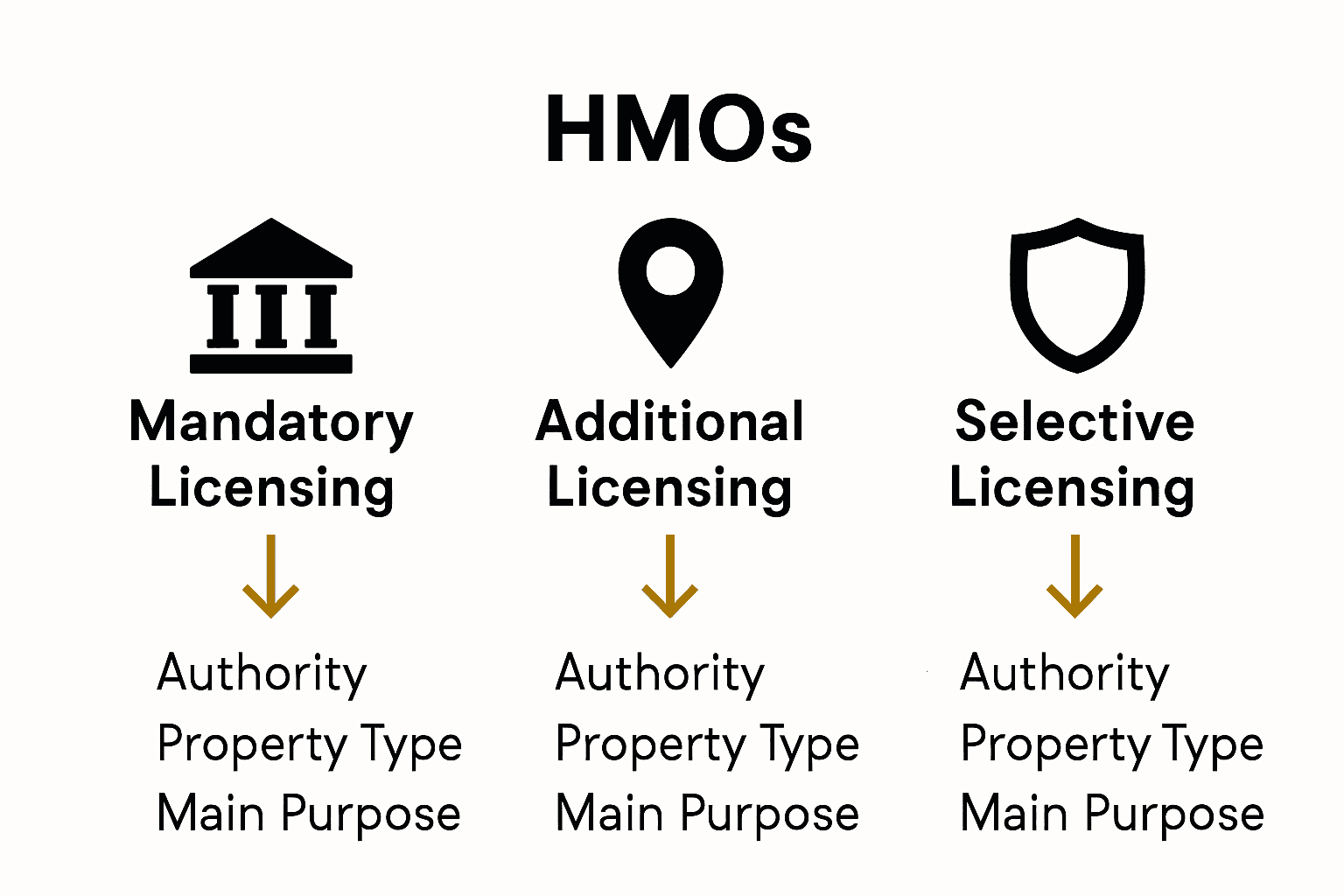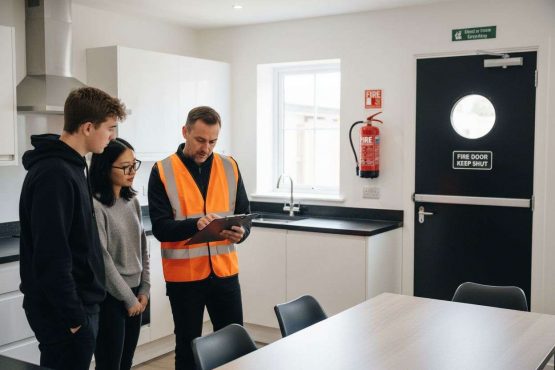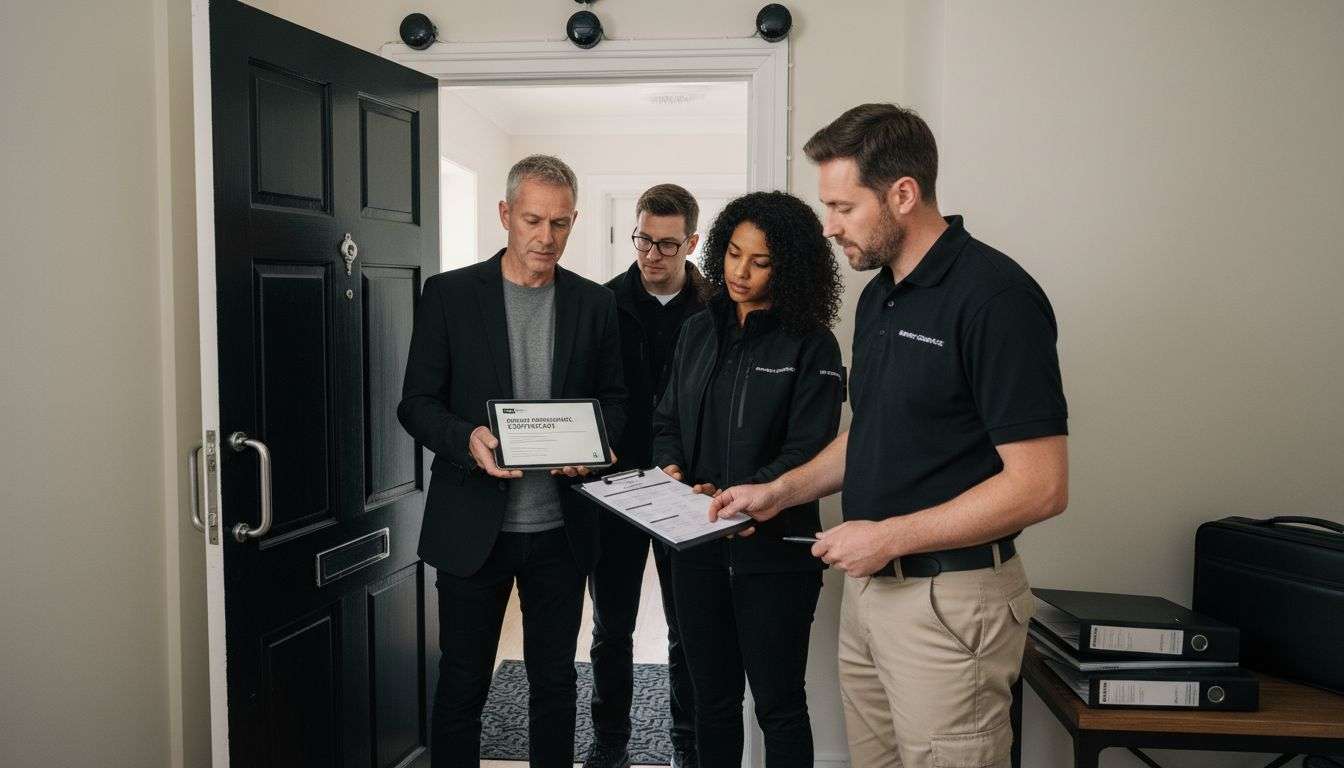Did you know over 500,000 homes in England fall under HMO regulations, with councils issuing thousands of fines each year for non-compliance? Shared housing brings unique responsibilities for property owners and managers. Regular HMO inspections are not just legal checks, they help protect tenants’ safety and set the standard for quality living. By understanding what inspectors look for, landlords can avoid heavy penalties and create safer, more comfortable homes for everyone.
Key Takeaways
| Point | Details |
|---|---|
| HMO Inspections Ensure Safety | HMO inspections are vital for maintaining tenant safety and legal compliance in shared residential properties. They assess critical areas such as fire safety and general maintenance standards. |
| Licensing Requirements Vary | Different types of HMO inspections exist based on occupancy and property characteristics, with mandatory licensing crucial for properties with five or more occupants. |
| Landlords Face Legal Responsibilities | HMO landlords must comply with stringent safety, licensing, and documentation obligations to avoid significant penalties and maintain safe living environments. |
| Non-Compliance Risks are High | Failure to adhere to HMO regulations can lead to severe financial penalties, damaged reputations, and limitations on future property management opportunities. |
Defining HMO Inspection And Its Core Purpose
A House in Multiple Occupation (HMO) inspection is a comprehensive property assessment designed to ensure tenant safety, legal compliance, and appropriate living standards in shared residential properties. According to official UK housing regulations, these inspections cover properties where at least three tenants from different households share common facilities like bathrooms or kitchens.
The core purpose of an HMO inspection goes beyond a simple property check. Read more about why HMO inspections matter for landlords and tenants alike. Inspections systematically evaluate critical aspects such as:
- Fire safety infrastructure
- Electrical system integrity
- Gas appliance and heating system compliance
- General property maintenance standards
- Adequate amenity provisions for shared living spaces
- Adherence to occupancy regulations
Local council housing departments typically conduct these inspections under the Management of Houses in Multiple Occupation (England) Regulations 2006. Their primary objective is proactively identifying potential health and safety risks before they escalate. Landlords found non-compliant during these assessments may be required to implement immediate improvements or face potential legal consequences, including significant financial penalties.
These thorough examinations protect vulnerable tenants by ensuring their living environment meets stringent safety and quality benchmarks. For property investors and landlords, understanding and preparing for HMO inspections isn’t just a legal requirement—it’s a fundamental responsibility in providing secure, habitable shared living spaces.
Types Of Inspections And Legal Framework In The UK
In the UK, HMO inspections are governed by a comprehensive legal framework designed to protect tenants and ensure property safety standards. According to government regulations, landlords face different licensing requirements depending on their property’s characteristics and occupancy levels. Check out our detailed HMO compliance checklist to understand these nuanced requirements.
The primary types of HMO inspections include:
Here’s a comparison of the primary HMO inspection types and their key features:
| Inspection Type | Applies To | Authority Imposing | Main Purpose |
|---|---|---|---|
| Mandatory Licensing Inspection | 5+ tenants from multiple households | National Government | Ensure high-occupancy HMO safety |
| Additional Licensing | Specified areas/property types | Local Council | Address local risks & non-mandatory HMOs |
| Selective Licensing | Designated vulnerable or high-risk areas | Local Council | Improve standards in targeted locations |
- Mandatory Licensing Inspections: Required for properties housing five or more tenants from multiple households
- Additional Licensing: Implemented by local authorities for specific areas or property types
- Selective Licensing: Targeting specific geographical zones with higher tenant vulnerability
According to official UK guidance, these inspections involve critical evaluations such as the Housing Health and Safety Rating System (HHSRS) risk assessment. Local authorities mandate that licensed HMOs undergo comprehensive risk assessments within five years of licensing, with landlords legally obligated to remedy any identified risks.
Failure to secure the appropriate licensing constitutes a criminal offence, potentially resulting in significant financial penalties. Landlords must proactively understand their legal obligations, with local councils empowered to enforce extra licensing requirements even on properties that might not meet national standard criteria. These rigorous inspection frameworks ultimately aim to guarantee safe, habitable living environments for tenants across multiple-occupancy properties.

Key Areas Assessed During An HMO Inspection
HMO property inspections are comprehensive assessments that scrutinize multiple critical aspects of shared living spaces. Learn essential tips for preparing for your HMO viewing, which can help landlords anticipate potential inspection challenges.
Inspectors conduct thorough evaluations across several key compliance areas:
-
Fire Safety Systems:
- Functional escape routes
- Properly maintained fire doors
- Operational fire extinguishers
- Working smoke and carbon monoxide alarms
-
Documentation and Certification:
- Valid gas safety certificates
- Up-to-date electrical safety records
- Energy Performance Certificates (EPC)
- Tenant occupancy documentation
According to industry guidelines, inspectors also focus on spatial standards and amenity provisions. This includes verifying room sizes, ensuring adequate facilities for the number of occupants, and checking waste management protocols. They assess whether communal areas are clean, sanitation facilities are sufficient, and the property is not overcrowded.
A critical aspect of HMO inspections is determining the property manager’s suitability. Inspectors evaluate whether the manager is a ‘fit and proper person’ by examining their professional conduct, financial reliability, and commitment to maintaining safe living standards. Non-compliance in any of these areas can result in significant penalties, making proactive management and regular self-assessment crucial for landlords.

Landlord Duties And Compliance Obligations
HMO landlords shoulder significant legal responsibilities that extend far beyond simple property ownership. Learn about the essential legal checklist for HMO management to ensure you stay fully compliant with current regulations.
Key compliance obligations for HMO landlords include:
-
Safety Certification:
- Annual gas safety inspections by Gas Safe‑registered engineers
- Maintain inspection records for minimum two years
- Provide tenant copies within 28 days of inspection
- Ensure comprehensive safety checks on pipework and appliances
-
Licensing and Documentation:
- Secure mandatory HMO licensing for properties with 5+ occupants
- Maintain licence validity (typically five years)
- Comply with local authority planning and building regulations
According to industry guidelines, landlords must meticulously manage multiple technical and administrative requirements. This includes conducting thorough fire risk assessments, installing appropriate fire doors, maintaining kitchen standards, and ensuring adequate sound insulation. Landlords are legally obligated to create and maintain living environments that meet stringent safety and habitability standards.
Non‑compliance can result in severe consequences, including substantial financial penalties, potential legal action, and revocation of rental licenses. Proactive management, regular property assessments, and staying updated with evolving regulations are crucial. HMO landlords must view these obligations not just as legal requirements, but as fundamental responsibilities to tenant safety and wellbeing.
Risks, Penalties, And Common Pitfalls
HMO property management involves navigating a complex landscape of legal risks that can have substantial financial and professional consequences. Discover essential tips to avoid common HMO compliance mistakes and protect your investment.
The most critical risks for landlords include:
-
Financial Penalties:
- Unlimited fines for operating without proper licensing
- Potential tenant rent reclaim up to 12 months
- Council enforcement fines reaching £30,000 per breach
- Potential mandatory rent repayment orders
-
Professional Reputation Risks:
- Inclusion in rogue landlord databases
- Potential criminal prosecution
- Loss of current and future licensing permissions
- Restrictions on property management activities
According to industry research, local councils have increasingly stringent enforcement mechanisms targeting non-compliant HMO operators. Common pitfalls that trigger these penalties include missing fire safety infrastructure, improper tenant capacity management, inadequate property maintenance, and failing to obtain mandatory licensing.
Beyond immediate financial penalties, landlords risk long-term professional damage. Being listed on rogue landlord databases can severely limit future property investment opportunities, making proactive compliance not just a legal requirement, but a critical business strategy. Successful HMO management demands meticulous attention to regulatory details, ongoing education, and a commitment to maintaining high safety and quality standards.
Confident HMO Inspections Start Here
Worried about preparing for your next HMO inspection or unsure if your property will meet all UK compliance standards? You are not alone. Many landlords and investors struggle with the pressure of regulatory checks, licensing requirements, and the risk of costly penalties. This guide has highlighted the real challenges that come with HMO ownership, from maintaining fire safety infrastructure to providing the right certification and facing intense legal scrutiny.
Take control of your peace of mind. Visit AgentHMO to explore solutions designed for every stage of the HMO journey. Here, you can access a trusted network of HMO service providers, discover up-to-date compliance resources, and connect with specialists in HMO property management. Ready to protect your investment and avoid critical pitfalls? Start your search for expert support and tailored compliance solutions today. Your next inspection can be a success—take action now before the next set of regulations arrives.
Frequently Asked Questions
What is an HMO inspection and its main purpose?
An HMO inspection is a comprehensive property assessment aimed at ensuring tenant safety and legal compliance in Houses in Multiple Occupation. The main purpose is to evaluate critical aspects such as fire safety, electrical systems, gas compliance, and overall property maintenance to protect residents and address potential risks.
What types of inspections are involved in HMO regulations?
There are three primary types of HMO inspections: Mandatory Licensing Inspections for properties with five or more tenants, Additional Licensing for specific local areas or property types, and Selective Licensing targeting designated vulnerable locations. Each type addresses different aspects of property compliance and safety.
What key areas are assessed during an HMO inspection?
Key areas assessed during an HMO inspection include fire safety systems, documentation and certification, spatial standards for occupancy, amenity provisions, and the suitability of the property manager. Evaluating these areas ensures the property meets safety and habitability standards for tenants.
What are the consequences of non-compliance with HMO regulations?
Non-compliance with HMO regulations can lead to significant financial penalties, including unlimited fines, potential tenant rent reclaim, and enforcement fines from local councils. Additionally, landlords may face reputational risks, potential criminal prosecution, and loss of licensing permissions, impacting future property investments.



